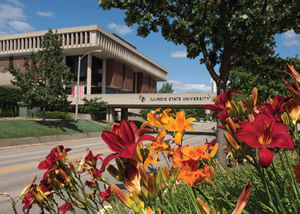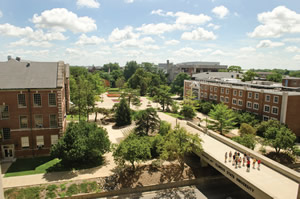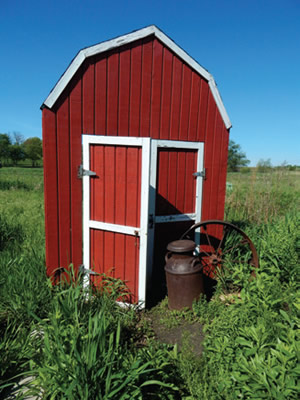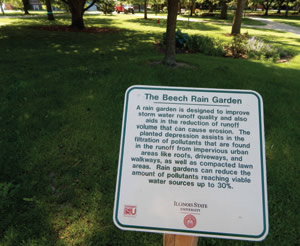Investing in Green

PHOTO © ILLINOIS STATE UNIVERSITY
Staff, students, faculty and administrators at Illinois State University (ISU) keep their proverbial ears close to the grounds. The grounds and fields, that is, of this large campus, where facilities management, academics and environmental awareness come together in evolving, proactive and telling ways.
The investment and attention to detail is evident, as with ISU’s many plantings, shade trees, bioswales, rain gardens and explanatory signage arranged throughout its busy quad, with each feature a part of an overall campus designated as an arboretum 20 years ago, with precise tree care policies and procedures. A large Horticulture Center is located nearby, and it is open to the community and is a collaborative teaching and learning venue for agriculture, botany and other students and volunteers. An abutting golf course is under the auspices of the Department of Athletics and is certified by the Audubon Cooperative Sanctuary Program, with provisions for its environmental planning, educational applications, water and chemical use, and community engagement.
The unified goal is not only to provide a “functional, attractive, safe environment for faculty, staff, students;” potential students; and all users of the campus; but also to foster an environment that integrates academics with sustainable facilities and their management, points out ISU’s Chuck Scott, director of Facilities Management.
Investing in First Impressions
That being said, much thinking and action goes into the moment when that initial visit takes place and impressions of the physical campus are formed. In a sense, “everyone who comes into contact with the grounds is a customer,” Scott explains.
The natural setting of ISU’s campus is a major draw for visitors from the surrounding communities of Bloomington and Normal and elsewhere, explains Patrick Murphy, director of the campus arboretum. There are other dimensions. As Murphy adds of the 490-acre arboretum, which includes the quad and contains thousands of trees of more than 100 varieties, “It’s important that diversity and best practices are conducted here. This is the largest classroom of the campus.”

PHOTO © ILLINOIS STATE UNIVERSITY
Today, the vast majority of potential students, faculty and staff with even a passing interest in an institution will likely look online first, meaning that by the first in-person visit, “you’ve already formed an opinion,” he says. Encountering the grounds, buildings and overall setting of a campus is a key moment — it’s a visceral, first-hand encounter that can either complement or buck formulating opinions. Those environs matter greatly to recruitment, quality of life, community relations and more. “It’s huge for recruitment,” as ISU Sustainability Coordinator Missy Nergard puts it. That factor — precisely how campus grounds affect recruitment — may be difficult to quantify, which as Nergard says can make some investments in grounds just as difficult to explain and propose for budgeting.
Creating outstanding grounds is not just about investing money, although that is certainly a part of the process. Making a vigorous, proactive effort to envision, create and maintain grounds is also about investing time and attention to staff training and development, cross-pollinating — and the pun is intended — initiatives across departments, and staying open to change. And change is right: “It’s sort of been an evolution,” Scott says of the effort on ISU’s campus over the years, whether it’s in terms of integrated pest management, herbicide use, how practices can impact allergies and more.
For example, one of the key moments, in Scott’s view, came some years ago when chemicals were used, by chance, near an air intake valve of a campus building, impacting scientific research being conducted inside. It was an eye-opener, leading to changes in what, where and when such applications are made to campus grounds.


PHOTOS © SCOTT BERMAN
HOW GREEN IS MY GARDEN? The Horticulture Center on the campus of Illinois State University provides a focal point and support for horticultural instruction and scholarship, as well as public demonstration and outreach. ISU students are actively engaged in community outreach, and learn from top-notch faculty. Future development will entail a building that will contain classrooms, offices, labs, greenhouses and several gardens.
The Science of Grounds Care
Caring for landscape, grounds and facilities takes a “scientific and proactive approach” today, and effectively implementing that approach requires proactive professional development, believes Scott (who incidentally is the incoming 2015-2016 president of APPA).
Taking the right approach matters along many lines. For one thing, students today — to what may seem a surprising degree to a casual observer — express interest, and occasionally frustration, related to the sustainability of campus landscape features. “Our students are looking for fewer chemicals and a more natural ecosystem,” Nergard says, “so they are frustrated when there are annuals out on the quad that are getting watered every year.” There is a preference for perennials, which imbibe less water and energy, and to an increasing degree, that preference is found not only among biology or environmental health majors, but also across other disciplines, says Nergard.
On a related point, ISU has an active Student Sustainability Committee under the auspices of the Student Government Association. The stated goal of the committee, in part: “programming and projects that increase awareness of the ecological, social and economic aspects of sustainability” as well as to serve as “a voice to the university administration” and a support to related student activities. To do that, the committee allocates $180,000 a year — student groups apply for funding — for related initiatives on campus that have included programs centering on water conservation awareness, an apiary, and solar thermal feasibility studies of campus rooftops. Incidentally, a Music Education major was a recent chair of that committee, Nergard notes, reflecting the broad-based interest in sustainability.
All told, it’s an important and intensifying interest among students and professionals on and off campuses — all the more reason to keep one’s ear close to the grounds.
SOME IDEAS ABOUT IMPACTFUL MANAGEMENT OF GROUNDS PROGRAMS
- Consider how you can make a difference in the near term and without remaking the wheel. Start the process by writing procedures, operational protocols and rules that support the missions of the institution, including its academic mission, ISU’s Scott suggests. It can be a long, tough process at any institution to get policy changes passed — a worthy goal, but how else can positive change happen?
- Bear in mind that grounds management can be a vehicle to develop impactful town-gown relationships. Encourage advocates who can reach out, liaise and coordinate efforts on everything from recycling to managing landscape waste and local stormwater runoff to volunteering at events to sponsorships to sharing equipment. ISU’s Scott, for example, has served in local municipal government, which has helped shepherd such collaboration.
- Design garden and landscape features that recognize, through name and description, ideals, achievements and people of distinction on your campus, past and present. In one example, ISU’s Quad has a Veterans Memorial Garden that acknowledges the university’s strong ROTC program, Nergard notes.
- Seek out local contractors willing and able to step outside their comfort zone and work with you on new processes or methods that enhance campus green and sustainability, says ISU’s Nergard.
This article originally appeared in the issue of .